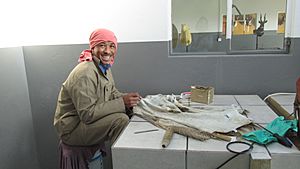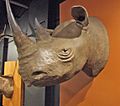Taxidermy facts for kids


Taxidermy is the art of making animals look alive even after they have died. The word "taxidermy" comes from Greek words meaning "arrangement of skin." It involves carefully taking the skin of an animal and putting it over a special fake body. If you do taxidermy, you are called a taxidermist.
Taxidermied animals can be put on display in many places. You might see them in a museum, a school, or even someone's home.
Contents
What is Taxidermy For?
People use taxidermy for different reasons.
For Education and Museums
Many taxidermied animals are found in museums. They are often used to create dioramas, which are scenes that show animals in their natural habitats. This helps people learn about different animals and where they live. For example, you might see a display of a lion in a savanna or a bear in a forest. These displays teach us about animal behavior and ecosystems.
For Hunters and Fishermen
Some hunters and fishermen choose to taxidermy the animals they catch. They often do this to keep them as trophies or mementos. It's a way to remember a successful hunt or fishing trip.
For Pets and Other Animals
Sometimes, people choose to taxidermy their beloved pets. This allows them to keep a physical reminder of their animal companion. It's a way to honor and remember a pet that has passed away.
How is Taxidermy Done?
Taxidermy is a detailed process that requires skill and knowledge.
Preparing the Skin
First, the taxidermist carefully removes the animal's skin. This skin is then cleaned and treated with special chemicals. This process, called tanning, helps to preserve the skin and prevent it from decaying. It makes the skin flexible and ready for the next steps.
Creating the Form
While the skin is being prepared, the taxidermist creates a fake body, called a "form." These forms are usually made from materials like foam or wood. They are shaped to match the exact size and posture of the animal. Sometimes, taxidermists use molds of the animal's actual body to make the form very accurate.
Mounting the Skin
Once the skin is ready and the form is complete, the skin is carefully placed over the form. The taxidermist then uses various tools to arrange the skin, making sure it looks natural. They pay close attention to details like the eyes, nose, and mouth to make the animal appear lifelike. Glass eyes are often used to give the animal a realistic gaze.
Finishing Touches
After the skin is mounted, the taxidermist adds the final touches. This might include painting certain areas, adding whiskers, or shaping the fur or feathers. The goal is to make the taxidermied animal look as real as possible, almost as if it could move at any moment.
Images for kids
-
Wilmer W. Tanner with a mounted tiger at the Brigham Young University Life Sciences Museum
-
Theodore Roosevelt's taxidermy kit, from a private collection
-
A moose and calf diorama at the Manitoba Museum
-
Two examples of traditional skin-mounts: a Lion and a Blue Wildebeest from Namibia
-
An example of damage to a freeze-dried taxidermy mount of a rattlesnake, possibly from dermestid beetles
See also
 In Spanish: Taxidermia para niños
In Spanish: Taxidermia para niños










